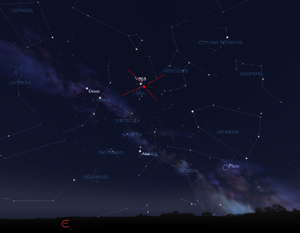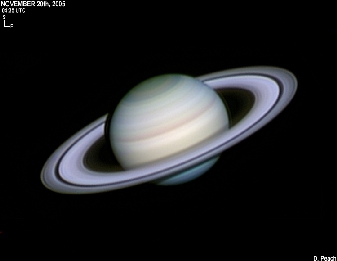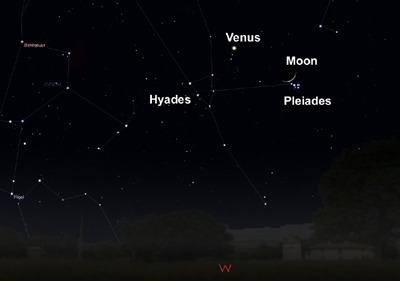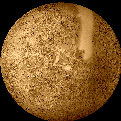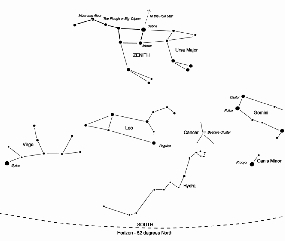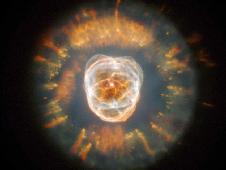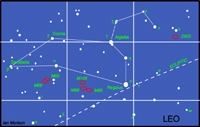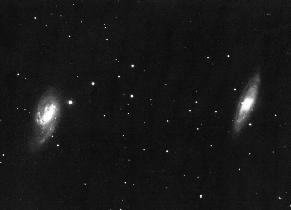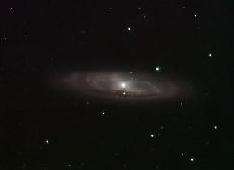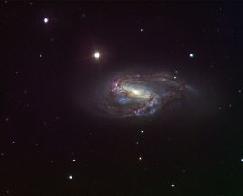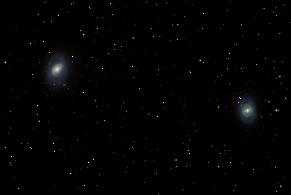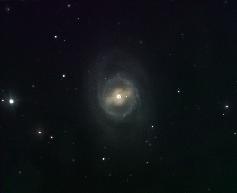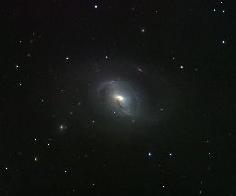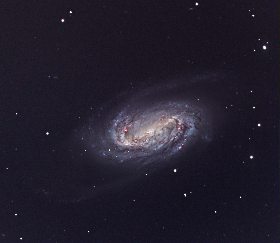The Night Sky April 2007
Compiled by Ian Morison
This page, updated monthly, will let you know some of the things that you can look out for in the night sky. It lists the phases of the Moon, where you will see the naked-eye planets and describes some of the prominent constellations in the night sky during the month.
Image of the Month
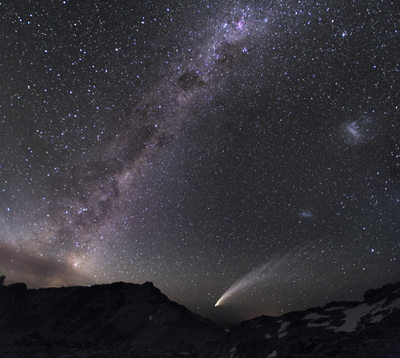
Comet Mcnaught and three galaxies - click on image to download a full resolution version
Image acknowledgement and copyright: Prof. Miloslav Druckmuller, Brno University of Technology.
This is one of the most beautiful astronomical images that I have ever seen and I thank Professor Druckmuller for allowing me to use it as the image of the month. It was taken from Patagonia in Argentina and is a mosaic of images spanning 100 degrees of the sky. The highlight is, of course, Comet McNaught which can rightly be called the "Great Comet" of 2007, though sadly our view of it in the UK did not compare with that seen in the southern hemisphere. The image also shows three galaxies; our own Milky Way galaxy - note the dark cloud near the centre top called the coalsack with, just above and to the right, the southern cross - and the two Magellanic Clouds above and to the right of the comets tail.
See more of Professor Druckmuller's images
The Moon
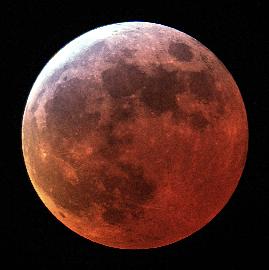
The passage of the Moon through the Earth's shadow March 2007: Cape Newwise 200 mm telescope and Nikon D80 camera.
Ian Morison, Jodrell Bank Observatory
| new | first quarter | full moon | last quarter |
|---|---|---|---|
| Apr 17th | Apr 24th | Apr 2nd | Apr 10th/td> |
Some Lunar Images by Ian Morison, Jodrell Bank Observatory: Lunar Images
Highlights of the Month
The Lyrid meteor Shower on the night of 22/23rd April
The Lyrid Meteor Shower - so called as the radiant (from where the meteor trails seem to radiate from) lies in the constellation Lyra. It peaks in the early morning of the 22nd April and is a reliable, though not spectacular, shower with perhaps up to 15 meteors seen per hour. The dust particles that cause the shower have been released by the comet Thatcher, discovered in 1861. Occasionally we pass through a dense clump of particles as happened in 1982 when over 90 meteors were seen per hour. So its worth waking up to have a look if clear around 1-2 am. Look to the East as ahown in the chart above.
A good month to observe Saturn
To see more of Damian Peache's Images: Damian Peache's website
Saturn is now high in the southern sky during the evening lying in the constellation of Leo close to the boarder with Cancer. It is at magnitude ~+0.3, so stands out amongst the stars - below and to the left of Gemini. Even a small telescope will show the rings and, if seeing conditions are good, one of the equatorial bands - though these are not nearly so well pronounced as on Jupiter. The lowest cost telescope that I would advise purchasing is the Skywatcher Explorer-130PM. This is a 5" aperture Newtonian with a driven mount and can be obtained from about 170 pounds. once the equatorial mount has been set up - with the equatorial axis pointing towards towards the "pole star" - then, once Saturn has been centered in the field of view, the polar axis moror should keep it in view with only occasional "tweaks" to the declination axis position.
The Cresent Moon close to Venus, the Pleaides and the Hyades
The chart above shows a nice grouping of objects in the early evening sky. Note that the light from the Sun has been removed to make the locations more obvious, but they will NOT be as easy to spot as the chart implies! Binoculars will help.
The Planets
Jupiter
Jupiter, lying in the constellation Ophiuchus, is at magnitude -2.3 at the beginning of April, rising at ~1 am low in the south-east. As the month progresses its magnitude will rise to -2.5 and it will rise earlier - at 11pm by the month's end. So Jupiter is still really a morning object. It is up and to the left of the red-giant star Antares in Scorpius. Sadly, Jupiter now lies along the most southerly part of the ecliptic, and will never reach the high elevation in the sky that we have enjoyed in recent years so our views will be hindered by the atmosphere, but a small telescope will easily show the four Galilean moons as they weave from side to side.
Saturn
Saturn is ideally placed to observe this month. It lies in the constellation Leo, but very close to the boundary of Cancer, about 11 degrees up and to the right of its brightest star Regulus. It reached "opposition" on the 10th February when it was due south around midnight and closest to us but now is highest in the sky earlier in the evening. Its magnitude is ~ +0.2 (reducing to +0.4 during the month) and its globe subtends an angle of ~20 arc seconds. The rings are closing and are now about 13 degrees from edge-on, so Saturn is shining less brightly than during the previous few years whilst the rings have been more open. Saturn is still, however, a beautiful sight in a small telescope. A 4 to 6 inch telescope will also easily show Saturn's largest moon, Titan, and an 8 inch three or four more.
See Highlight Above
The image was taken as the Cassini spacecraft neared Saturn at the start of its exploration of the planet and its moons - particularly Titan.
Mercury
Mercury reached elongation on the 23rd of March when 28 degrees from the Sun but is now closing on the Sun's position so making it very hard to see. Not a good month for Mercury I am afraid.
Note that the blank region in the image above is simply because this part of Mercury's surface has not yet been imaged in detail.
Mars
Mars doesn't have a good month either as it is only visible just before dawn close to the southeastern horizon. Its disk is just 5 arc seconds across and it shines at magnitude 1.1. We really need to wait a few months before we see it well.
Venus
Venus is now on the eastern side of the Sun, becoming visible after sunset and dominates the western sky, setting a few hours after the Sun. With a magnitude of -4 it can hardly be missed! As the months progress, the phase will reduce and the angular size will increase. This has the interesting consequence that the "apparent reflecting area" stays almost constant and hence the magnitude stays very close to -4 for quite a few months. It was the fact that Venus could show almost full phases that showed Galileo that Venus at times lie beyond the Sun and hence the Copernican theory of ther Solar system must be correct.
Find more planetary images and details about the Solar System: The Solar System
The Stars
The mid evening April Sky
This map shows the constellations seen in the south in mid-evening.
The constellation Gemini is now setting towards the south-west and Leo holds pride (sic) of place in the south with its bright star Regulus. Between Gemini and Leo lies Cancer. Close to the boundary of these two constellation is where, this month, the planet Saturn may be found. It is well worth observing with binoculars to see the Beehive Cluster at its heart. Below Gemini is the tiny constellation of Canis Minor whose only bright star is Procyon. Rising in the south-east is the constellation Virgo whose brightest star is Spica. Though Virgo has few bright stars it is in the direction of of a great cluster of galaxies - the Virgo Cluster - which lies at the centre of the supercluster of which our local group of galaxies is an outlying member. The constellation Ursa Major is high in the northern sky during the evening this month and contains many interesting objects.
The constellation Gemini
Gemini - The Twins - lies up and to the left of Orion and is in the south-west during early evenings this month. It contains two bright stars Castor and Pollux of 1.9 and 1.1 magnitudes respectivly. Castor is a close double having a separation of ~ 3.6 arc seconds making it a fine test of the quality of a small telescope - providing the atmospheric seeing is good! In fact the Castor system has 6 stars - each of the two seen in the telescope is a double star, and there is a third, 9th magnitude, companion star 73 arcseconds away which is alos a double star! Pollux is a red giant star of spectral class K0. The planet Pluto was discovered close to delta Geminorum by Clyde Tombaugh in 1930. The variable star shown to the lower right of delta Geminorum is a Cepheid variable, changing its brightness from 3.6 to 4.2 magnitudes with a period of 10.15 days
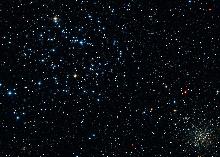
M35 and NGC 2158
This wonderful image was taken by Fritz Benedict and David Chappell using a 30" telescope at McDonal Observatory. Randy Whited combined the three colour CCD images to make the picture
M35 is an open star cluster comprising several hundred stars around a hundred of which are brighter than magnitude 13 and so will be seen under dark skies with a relativly small telescope. It is easily spotted with binoculars close to the "foot" of the upper right twin. A small telescope at low power using a wide field eyepiece will show it at its best. Those using larger telescopes - say 8 to 10 inches - will spot a smaller compact cluster NGC 2158 close by. NGC 2158 is four times more distant that M35 and ten times older, so the hotter blue stars will have reached the end of their lives leaving only the longer-lived yellow stars like our Sun to dominate its light.
To the lower right of the constellation lies the Planetary Nebula NGC2392. As the Hubble Space Telescope image shows, it resembles a head surrounded by the fur collar of a parka hood - hence its other name The Eskimo Nebula. The white dwarf remnant is seen at the centre of the "head". The Nebula was discovered by William Herschel in 1787. It lies about 5000 light years away from us.
The constellation Leo
The constellation Leo is now in the south-eastern sky in the evening. One of the few constellations that genuinely resembles its name, it looks likes one of the Lions in Trafalger Square, with its main and head forming an arc (called the Sickle) to the upper right, with Regulus in the position of its right knee. Regulus is a blue-white star, five times bigger than the sun at a distance of 90 light years. It shines at magnitude 1.4. Algieba, which forms the base of the neck, is the second brightest star in Leo at magnitude 1.9. With a telescope it resolves into one of the most magnificent double stars in the sky - a pair of golden yellow stars! They orbit their common centre of gravity every 600 years. This lovely pair of orange giants are 170 light years away.
Leo also hosts two pairs of Messier galaxies which lie beneath its belly. The first pair lie about 9 degrees to the west of Regulus and comprise M95 (to the east) and M96. They are almost exactly at the same declination as Regulus so, using an equatorial mount, centre on Regulus, lock the declination axis and sweep towards the west 9 degrees. They are both close to 9th magnitude and may bee seen together with a telescope at low power or individually at higher powers. M65 is a type Sa spiral lying at a distance of 35 millin klight years and M66, considerably bigger than M65, is of type Sb. Type Sa spirals have large nuclei and very tightly wound spiral arms whilst as one moves through type Sb to Sc, the nucleus becomes smaller and the arms more open.
The second pair of galaxies, M95 and M96, lie a further 7 degrees to the west between the stars Upsilon and Iota Leonis. M95 is a barred spiral of type SBb. It lies at a distance of 38 million light years and is magnitude 9.7. M96, a type Sa galaxy, is slightly further away at 41 million light years, but a little brighter with a magnitude of 9.2. Both are members of the Leo I group of galaxies and are visible together with a telescope at low power.
There is a further ~9th magnitude galaxy in Leo which, surprisingly, is in neither the Messier or Caldwell catalogues. It lies a little below lambda Leonis and was discovered by William Herschel. No 2903 in the New General Catalogue, it is a beautiful type Sb galaxy which is seen at somewhat of an oblique angle. It lies at a distance of 20.5 million light years.
The constellation Virgo
Virgo, rising in the east in late evening this month, is not one of the most prominent constellations, containing only one bright star, Spica, but is one of the largest and is very rewarding for those with "rich field" telescopes capable of seeing the many galaxies that lie within its boundaries. Spica is, in fact, an exceedingly close double star with the two B type stars orbiting each other every 4 days. Their total luminosity is 2000 times that of our Sun. In the upper right hand quadrant of Virgo lies the centre of the Virgo Cluster of galaxies. There are 13 galaxies in the Messier catalogue in this region, all of which can be seen with a small telescope. The brightest is the giant elliptical galaxy, M87, with a jet extending from its centre where there is almost certainly a massive black hole into which dust and gas are falling. This releases great amounts of energy which powers particles to reach speeds close to the speed of light forming the jet we see. M87 is also called VIRGO A as it is a very strong radio source.
Below Porrima and to the right of Spica lies M104, an 8th magnitude spiral galaxy about 30 million light years away from us. Its spiral arms are edge on to us so in a small telescope it appears as an elliptical galaxy. It is also known as the Sombrero Galaxy as it looks like a wide brimmed hat in long exposure photographs.
The constellation Ursa Major
The stars of the Plough, shown linked by the thicker lines in the chart above, form one of the most recognised star patterns in the sky. Also called the Big Dipper, after the soup ladles used by farmer's wives in America to serve soup to the farm workers at lunchtime, it forms part of the Great Bear constellation - not quite so easy to make out! The stars Merak and Dubhe form the pointers which will lead you to the Pole Star, and hence find North. The stars Alcor and Mizar form a naked eye double which repays observation in a small telescope as Mizar is then shown to be an easily resolved double star. A fainter reddish star forms a triangle with Alcor and Mizar.
Ursa Major contains many interesting "deep sky" objects. The brightest, listed in Messier's Catalogue, are shown on the chart, but there are many fainter galaxies in the region too. In the upper right of the constellation are a pair of interacting galaxies M81 and M82 shown in the image below. M82 is undergoing a major burst of star formation and hence called a "starburst galaxy". They can be seen together using a low power eyepiece on a small telescope.
Another, and very beautiful, galaxy is M101 which looks rather like a pinwheel firework, hence its other name the Pinwheel Galaxy. It was discovered in1781 and was a late entry to Messier's calalogue of nebulous objects. It is a type Sc spiral galaxy seen face on which is at a distance of about 24 million light years. Type Sc galaxies have a relativly small nucleus and open spiral arms. With an overall diameter of 170,000 light it is one of the largest spirals known (the Milky Way has a diameter of ~ 130,000 light years).
Though just outside the constellation boundary, M51 lies close to Alkaid, the leftmost star of the Plough. Also called the Whirlpool Galaxy it is being deformed by the passage of the smaller galaxy on the left. This is now gravitationally captured by M51 and the two will eventually merge. M51 lies at a distance of about 37 million light years and was the first galaxy in which spiral arms were seen. It was discovered by Charles Messier in 1773 and the spiral structure was observed by Lord Rosse in 1845 using the 72" reflector at Birr Castle in Ireland - for many years the largest telescope in the world.
Lying close to Merak is the planetary nebula M97 which is usually called the Owl Nebula due to its resemblance to an owl's face with two large eyes. It was first called this by Lord Rosse who drew it in 1848 - as shown in the image below right. Planetary nebulae ar the remnants of stars similar in size to our Sun. When all possible nuclear fusion processes are complete, the central core collpses down into a "white dwarf" star and the the outer parts of the star are blown off to form the surrounding nebula.


